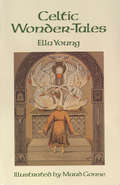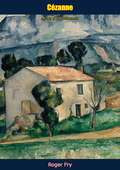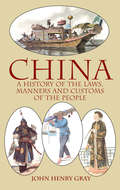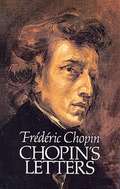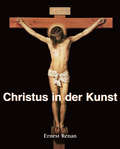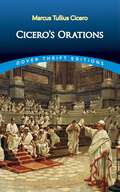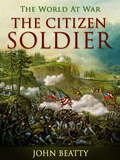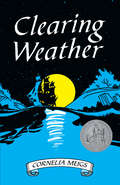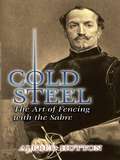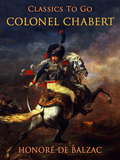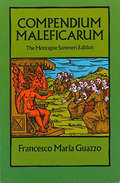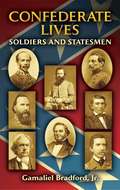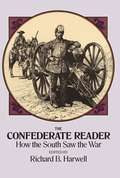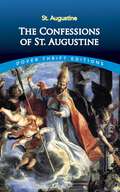- Table View
- List View
Celtic Wonder-Tales
by Maud Gonne Ella YoungIrish poet and mythologist Ella Young recounts 14 age-old yarns of ghosts, banshees, haunted castles, and mischievous sprites. Imaginatively illustrated by noted Irish artist and patriot Maud Gonne, these exciting narratives of magical doings in the twilit world of Celtic legend will enchant readers of all ages.The tales include "The Earth-Shapers," "The Spear of Victory," "The Cow of Plenty," "The Great Battle," "The Golden Fly," "The Children of Lir," and eight others, all abounding in the sly charm, whimsy, and flights of fancy that give Celtic folklore its special appeal.
A Century of Dishonor: The Classic Exposé of the Plight of the Native Americans (Native American)
by Helen Hunt JacksonSharply critical of the United States government's cruelty toward Native Americans, this monumental study describes the maltreatment of Indians as far back as the American Revolution. Focusing on the Delaware and the Cheyenne, the text goes on to document and deplore the sufferings of the Sioux, Nez Percé, Ponca, Winnebago, and Cherokee — in the process revealing a succession of broken treaties, the government's forced removal of tribes from choice lands, and other examples of inhuman treatment of the nation's 300,000 Indians. Stirring and eloquently stated, A Century of Dishonor was written in the hope of righting the wrongs inflicted upon this nation's first inhabitants. Within a year following its publication (1881), the book helped create the powerful Indian Rights Association. Decades later, author and critic Allen Nevins described the volume as "one of the soundest and most exhaustive works" ever written about Indian rights. Still a valuable reference, this book will be welcomed by students, historians, and others interested in the plight of Native Americans.
A Century of Emancipation
by John HarrisA Century of Emancipation, written by the English anti-slavery campaigner John Harris and first published in 1933, represents an invaluable compendium for the student of slavery and its allied forms of contract labor and forced labor, both in their historical setting and in their contemporary aspects. In this book, the author is concerned with all kind of slavery, including that of East Indians and Mongolians in the West Indies, of Kanakas in Polynesia, and of the motley crowd along the Putumayo River in South America.This book is not merely an attempt to portray suffering, it is also an attempt to give a brief account of the systems under which these things have been done, and still more an effort to recount the light and shade of the great struggles carried on by a mere handful of earnest souls beginning with Clarkson, Wilberforce, Buxton, Pitt, Sturge, Macaulay, Lushington. Grey, Livingstone, then on to Vandervelde, Dilke, Fox Bourne, Morel, Hodgkin and others.The book shows how those who have struggled and are still struggling with these sordid but powerful forces have never numbered more than a few hundreds. Whilst it may be true that those few hundreds have been men and women of wisdom and influence, yet it is even more true that they have been men and women possessed of souls burning with a spiritual passion for freedom and justice—that was and is their chief source of strength.
Cézanne: A Study of His Development
by Roger FryThe late Roger Fry was an art critic of unequalled perception and influence. One of his missions was to work for a better understanding of the Impressionist school and, above all, to claim for Cézanne (1839-1906) the great place that was rightfully his. In CÉZANNE Fry wrote a critical analysis which in many aspects has never been surpassed. He achieved with conspicuous success a two-fold aim: to show the essential development of the painter’s genius and to approach his work as it really is; as Fry himself words it, to detect the profound difference between Cézanne’s message and what we have made of it.”The result is a book, couched in Fry’s most lucid, penetrating manner, which is of great technical value to the painter and student, and which offers to the layman an illuminating demonstration of the essential nature of Cézanne’s art.
China: A History of the Laws, Manners and Customs of the People
by John Henry GrayThis highly readable history of the world's most populous country dates from the late nineteenth century, when its author, John Henry Gray, served as the Archdeacon of Hong Kong. His two-volume study, here bound into a single volume, begins with the earliest known legends of China as the "Middle Kingdom," around which all lesser states gathered like satellites, and ranges forward to an intriguing series of portraits of the author's Chinese contemporaries.Subjects include the functions and powers of government; prisons and forms of punishment; religion, gods, and goddesses, and Confucian philosophy; marriage and divorce; the roles of servants and slaves; festivals, amusements, and sports; funerals; astrology and fortune-telling; and benevolent institutions. Commercial activities — agricultural techniques, tea and silk production, and maritime pursuits — also receive detailed and informative treatments.Evocative illustrations include images of fireworks and flying kits, opium smokers and Buddhist nuns, traditional fishing techniques, and numerous other scenes from daily life. Of immense value to Sinologists and historians, this insightful volume will appeal to anyone interested in China and Far Eastern cultures.
Chopin's Letters (Dover Books on Music)
by E. L. Voynich Frederic ChopinThis superbly edited selection of nearly 300 of Chopin's letters, the first to be published in English, vividly reveals the composer as man and artist, and evokes the remarkable age — Europe of the 1830s and 1840s — he shared with an equally remarkable cast of characters, from Jenny Lind to Isabella II of Spain, from Queen Victoria to George Sand, from Heinrich Heine to Victor Hugo. Originally collected by the Polish musicologist Henryk Opienski, the letters have been translated and annotated by Chopin scholar E. L. Voynich. Students and admirers of Chopin will find in their pages vast resources to deepen their love and appreciation for — and wonderment at — the unique individuality and achievement of this great musical personality.
Christus in der Kunst
by Ernest RenanSeit der Geburt des Christentums sind Künstler fasziniert von Christus. Sein Abbild erscheint auf Fresken in Katakomben aus der Römerzeit, auf Buntglasscheiben in gotischen Kirchen sowie in verschiedenen Darstellungen in der heutigen Pop- Kultur. Der biblische Erlöser ist keine statische, körperlose Gottheit: Christi Geburt, sein ungewöhnliches Leben und sein dramatischer Tod machen ihn zu einem interessanten Motiv für religiöse und säkulare Künstler. Ob sie die Geistlichkeit des Leibhaftigen oder die menschlichen Charakteristika eines Mannes aus Fleisch und Blut zeigen, künstlerische Darstellungen Christi sind die umstrittensten, bewegendsten oder inspirierendsten Beispiele religiöser Kunst. Dieses reich illustrierte Buch erforscht verschiedene christliche Darstellungen, von Cimabues Krippenszenen über die Kreuzigungsdarstellungen Fra Angelicos bis hin zu den provozierenden Porträts Dalís und Andre Serranos. Der Autor Joseph Lewis French führt den Leser durch die ikonischen Darstellungen Christi in der Kunst. Zart oder graphisch, klassisch oder bizarr verdeutlichen diese Messiasbilder die verschiedenen Rollen des Gottessohns im sozialen Bereich wie auch im persönlichen Leben der Künstler.
Chronicles of the Crusades
by Jean De Joinville Geoffrey Villehardouin Sir Frank MarzialsThis book features two eyewitness accounts of the Crusades: Villehardouin's Chronicle of the Fourth Crusade and the Conquest of Constantinople and Joinville's Chronicle of the Crusade of St. Lewis. A pair of engrossing narratives by actual participants, these are among the most authoritative accounts available of the medieval Holy Wars. They recount terrifying scenes from the battlefields that recapture the horror of warfare, and offer invaluable insights into the religious and political fervor that sparked the two hundred-year campaign. The first reliable history of the Crusades, Villehardouin's work spans the era of the Fourth Crusade, from 1199-1207. It traces the path of a small army of crusaders who despite overwhelming odds captured the city of Constantinople. Joinville's chronicle focuses on the years 1248-1254, the time of the Seventh Crusade. Written by a prominent aid to King Louis of France, it offers personal perspectives on the pious monarch and his battles in the Holy Lands. Both of these highly readable histories provide rare glimpses of medieval social, economic, and cultural life in the context of the crusaders' quest for honor, piety, and glory.
Cicero's Orations: In Catilinam I-iv, Pro Caelio, Pro Milone, Pro Archia (Dover Thrift Editions)
by Marcus Tullius Cicero Charles Duke YongeThe greatest orator of the late Roman Republic, Marcus Tullius Cicero (106–43 B.C.), influenced the course of European letters for centuries after his death. Through his writings, Renaissance and Enlightenment scholars encountered the riches of Classical rhetoric and philosophy. The elegance of his style, his skill and erudition, his worldly wisdom, and his profound humanity made Cicero a model for latter-day thinkers and keep his works ever relevant. This collection presents examples of rhetoric from throughout the ancient Roman's illustrious career. Selections include a series of famous speeches delivered during Cicero's term as consul which thwarted the Catiline conspiracy to overthrow the Republic — but led to his own prosecution and exile. The compilation concludes with the bold orations delivered in defiance of Marc Anthony, which sealed Cicero's doom.
The Citizen-Soldier: Or; Memoirs Of A Volunteer (The World At War)
by John BeattyJohn Beatty (December 16, 1828 – December 4, 1914) was an American banker and statesman from Sandusky, Ohio. He served as a brigadier general in the Union Army during the American Civil War. (Excerpt from Wikipedia)
The City of Tomorrow and Its Planning (Dover Architecture)
by Le Corbusier Frederick EtchellsIn this 1929 classic, the great architect Le Corbusier turned from the design of houses to the planning of cities, surveying urban problems and venturing bold new solutions. The book shocked and thrilled a world already deep in the throes of the modern age.Today it is revered as a work that, quite literally, helped to shape our world. Le Corbusier articulates concepts and ideas he would put to work in his city planning schemes for Algiers, São Paulo, Rio de Janeiro, Buenos Aires, Barcelona, Geneva, Stockholm, and Antwerp, as well as schemes for a variety of structures from a museum in Tokyo to the United Nations buildings. The influence it exerted on a new generation of architects is now legendary.The City of To-morrow and Its Planning characterizes European cities as a chaos of poor design, inadequate housing, and inefficient transportation that grew out of the unplanned jumble of medieval cities. Developing his thesis that a great modern city can only function on a basis of strict order, Le Corbusier presents two imposing schemes for urban reconstruction — the "Voisin" scheme for the center of Paris, and his more developed plans for the "City of Three Million Inhabitants," which envisioned, among other things, 60-story skyscrapers, set well apart, to house commercial activities, and residential housing grouped in great blocks of "villas."For those who live in cities as well as anyone interested in their planning, here is a probing survey of the problems of modern urban life and a master architect's stimulating vision of how they might be solved, enlivened by the innovative spirit and passionate creativity that distinguished all of Le Corbusier's work.
Civil War Collector's Encyclopedia: Arms, Uniforms and Equipment of the Union and Confederacy (Civil War)
by Francis A. LordThis comprehensive reference will be invaluable to anyone requiring accurate data on the Civil War period. Indispensable for identifying, describing, and understanding the use of more than 800 items, the text is arranged alphabetically by topic, with subjects ranging from artillery accouterments, heavy cannon, boats, and barracks equipment to bridge materials, a charcoal water filter, brass name stencils (to label personal equipment), and an enormous variety of weapons. Material is cross-referenced for quick location of individual entries. "Everything an interested reader would want to know . . . A must-have book." — Antiques & Auction News. Over 350 rare illustrations.
Civil War Hospital Sketches (Civil War)
by Louisa May AlcottBefore her wider fame as the author of Little Women, Louisa May Alcott achieved recognition for her accounts of her work as a volunteer nurse in an army hospital. Written during the winter of 1862–63, her lively dispatches appeared in the newspaper Commonwealth, where they were eagerly read by soldiers' friends and families. Then, as now, these chronicles revealed the desperate realities of battlefield medicine as well as the tentative first steps of women in military service.Writing under a pseudonym, Alcott recounted the vicissitudes of her two-day journey from her home in Concord, Massachusetts, to Washington, D.C. A fiery baptism in the practice of nursing awaited her at Washington Hospital, were she arrived immediately after the slaughter of the Army of the Potomac at the battle of Fredericksburg. Alcott's rapidly paced prose graphically depicts the facts of hospital life, deftly balancing pathos with gentle humor. A vivid and truthful portrait of an often overlooked aspect of the Civil War, this book remains among the most illuminating reports of the era's medical practices as well as a moving testimonial to the war's human cost.
Classic French Fashions of the Twenties (Dover Pictorial Archive Ser.)
by Atelier BachwitzThis fine reproduction of a 1929 French fashion catalog features styles for all occasions. More than 50 color illustrations showcase elegant dresses, gowns, and coats from the designers of an influential and internationally renowned studio. Designs include a promenade and party frocks of silk, lace, and taffeta, all in the era's distinctive dropped-waist, knee-length mode, forming a panorama of fashions favored by flappers, society matrons, and other women of the 1920s.A rare source of authentic period styles, this volume will prove an excellent guide for designers, costume historians, and collectors of vintage apparel. Color images of Jazz Age fashions are few and far between, and these full-page illustrations offer clear views of trimmings, seaming, and other details. Notes on each model include information about the costume's intended season and occasion, fabrics, and accessories.
Classic Sailing-Ship Models in Photographs (Dover Maritime Series)
by R. Morton NanceLoving tribute to the often startlingly beautiful sailing vessels of a bygone age, charmingly depicted in over 120 handsome photographs and 28 drawings. Flemish Carrack, c. 1450; the Norske Löve, 1634; the 90-gun Albemarle, 1680; a Venetian trading Galeass, 1726; a Dutch East Indiaman, c. 1740; and the Great Republic, an American clipper, 1853.
Clearing Weather
by Cornelia MeigsYoung Nicholas Drury has his hands full between looking after his ailing uncle and tending to the family business, a Massachusetts shipyard. Since the recent end of the Revolutionary War, shipbuilding is in decline and everyone in the town of Brascombe is feeling the economic pinch. Just as Nicholas is on the verge of giving up and declaring bankruptcy, he notices footprints in his backyard that lead him to new friends, a dangerous secret, and a plan to restore the community's fortunes. <p><p> This Newbery Honor–winning novel for young readers recaptures the nation's anxious mood in the years that followed its newly won independence. The tale of an entire town pulling together and pitching in to build a great trading ship echoes the spirit of the American Revolution, and its account of the vessel's two-year adventure to the Caribbean and China reflects the young country's growing engagement with the wider world. Numerous atmospheric black-and-white illustrations add to the story's historical flavor.
Cold Steel: The Art of Fencing with the Sabre (Dover Military History, Weapons, Armor Ser.)
by Alfred Hutton Ramon MartinezA pioneer of modern fencing, Alfred Hutton was the first president of the Amateur Fencing Association and a father of modern research into the Western combat arts. In addition to his lectures about ancient weapons and his demonstrations of their use, Hutton created this 1889 classic, a continuing source of instruction and enlightenment to modern readers.The techniques associated with the sabre differ markedly from those of the épeé and the rapier. This study offers both technical and historical views of the art of the sabre. It begins with a look at the weapon's construction and its grip, followed by explanations of a variety of different strokes and parries as well as methods of combining attack and defense. Additional topics include approaches suitable for left-handed fencers, ceremonial aspects of the art, and contrasts between the sabre, the bayonet, and the French sword. Descriptions of associated weapons cover the great stick and the constable's truncheon, and the book concludes with considerations of the short sword-bayonet, or dagger. Fifty-five illustrations demonstrate how to hold the sabre, how to parry and guard, seizure, and numerous other aspects of the art of fencing with a sabre.
The Collected Legal Papers
by Oliver Wendell Holmes Jr.Oliver Wendell Holmes (1841–1935) is ingrained in American history as one of the country's foremost jurists. Distinguished for his learning, judgment, humor, and eloquence, he served as justice of the United States Supreme Court for four decades. Throughout his career, Holmes forged new concepts of the origin and nature of law. He viewed the law as a social instrument rather than as a set of abstract principles, and his ideas were seminal in the development of modern free-speech legislation. His retirement in 1932 was a national event, and he remains today one of the most influential members to have ever served on the Supreme Court.This volume compiles twenty-six of Oliver Wendell Holmes's legal papers and addresses, an important collection of opinions and dissents that touch every field of our national activity and reflect the ongoing development of a democratic society. Included is the famous article "Early English Equity," along with Holmes's essay on "The Path of the Law," which is regarded as the most significant index to his legal work.
Colonel Chabert (The World At War)
by Honoré BalzacLe Colonel Chabert (English: Colonel Chabert) is an 1832 novella by French novelist and playwright Honoré de Balzac (1799–1850). It is included in his series of novels (or Roman-fleuve) known as La Comédie humaine (The Human Comedy), which depicts and parodies French society in the period of the Restoration (1815–1830) and the July Monarchy (1830–1848). This novella, originally published in Le Constitutionnel, was adapted for six different motion pictures, including two silent films. (Excerpt from Wikipedia)
The Colonial Craftsman
by Carl BridenbaughIn colonial America, craftsmen comprised the largest segment of the population, after farmers. They were cabinetmakers, silversmiths, pewterers, printers, painters, engravers, blacksmiths, brass button-makers, shipwrights, hatters, shoemakers, and other artisans, and they manufactured the tools, clothing, household goods, and other essential products needed to sustain life and trade in the New World. <p><p> In this superb study, a distinguished American historian examines the lives and work of American craftsmen in the years before the Revolution — the golden age of colonial craftsmanship — showing them at work, at play, at worship, at school, at home, competing in their trades, striving to get ahead, and playing a dynamic role as citizens in bringing about American independence.Natural resources, special crafts of the different colonies, and New World "marketing" of those crafts are closely studied. Students of American history, culture, and the arts and crafts will find this a richly rewarding study — authoritative, well-researched, and highly readable. It is further enhanced with carefully chosen illustrations from Diderot's Encyclopédie, the great 18th-century reference work on technology, whose detailed engravings accurately represent the crafts of the period.
Compendium Maleficarum: The Montague Summers Edition
by Francesco Maria GuazzoThis extraordinary document, considered one of the most important manuals ever compiled on witchcraft, offers striking insight into the early seventeenth-century mind and society's attempts to cope with the evils it saw manifested in sorcery.A collection of writings by the Ambrosian monk Francesco Maria Guazzo, the Compendium comprehensively and penetratingly describes the entire practice and profession of witchcraft. First published in 1608, the commentaries came at an appropriate time. Contemporary accounts noted that witchcraft and sorcery had "spread in all directions," leaving "no country, town, village, or district, no class of society" free from the practice. This probing work, by a distinguished writer and scholar who perceived the devil as an evil force seeking to destroy men's bodies and souls, was an attempt to help man live piously and devoutly, thus guarding against such seductions and manipulations.Reproduced from a rare limited edition published in 1929 and supplemented with many erudite editorial notes by the Rev. Montague Summers, the Compendium Maleficarum includes profoundly serious discussions of witches' pacts with the devil, finely detailed descriptions of witches' powers, poisons, and crimes; sleep-inducing spells and methods for removing them, apparitions of demons and specters, diseases caused by demons, and other topics. Also examined in detail are witches' alleged powers to transport themselves from place to place, create living things, make beasts talk and the dead reappear; witches' use of religion to heal the sick, laws observed by witches to cause and cure illness, differences between demoniacs and the bewitched, and other subjects from the realm of the supernatural.Here is an encyclopedic tract of incalculable worth to the historians and student of the occult and anyone intrigued by necromantic lore, sabbats, sorceries, and trafficking with demons.
Confederate Lives: Soldiers and Statesmen (Civil War)
by Gamaliel BradfordThe distinguished historian Gamaliel Bradford, Jr.--author of Lee, the American and other acclaimed Civil War biographies--offers portraits of eight key leaders of the Confederacy. Bradford's skills at compiling concise profiles are at their finest in these compelling sketches of prominent figures in the Southern Cause.Commanding officers include Joseph E. Johnston, the highest-ranking U.S. Army officer to resign and join the Confederacy; the war's most famous cavalryman, J. E. B. Stuart; Lee's "Old War Horse," James Longstreet, who served from Manassas to Appomattox; P. G. T. Beauregard, winner of the nearly bloodless victory at Fort Sumter; and Rear Admiral Raphael Semmes, so successful in battle that he was charged at the war's end with treason and piracy. Confederate statesmen include U.S. Senator Judah P. Benjamin, appointed by Jefferson Davis as Confederate attorney general, secretary of war, and secretary of state; Vice-President of the Confederate States, Alexander H. Stephens; and Senator Robert Toombs, who evolved from conservative Unionist to ardent secessionist.The book concludes with the "high water mark" of the Confederacy at Gettysburg and examines the effects of that momentous battle. Previously available only in expensive, hard-to-find editions, this volume is a rare find for Civil War buffs.
The Confederate Reader: How the South Saw the War (Civil War Ser.)
by Richard B. HarwellFor any student of the War Between the States, this treasury of contemporary documents—all but a few written by Southerners — offers a wealth of insight and perspectives on life in the South during the conflict, how newspapers and periodicals covered events, and how Southerners reacted to the disastrous struggle that disrupted their lives and ravaged their homes, farms, and cities. Selections have been arranged in an order that demonstrates the progress of the war, beginning with a South Carolina ordinance to secede from the Union and ending with a final message in 1865 from the last Confederate general to surrender. Relive the day-to-day reality of the War as captured in a rich legacy of written records: official battle reports, general orders, letters, sermons, songs, published articles, novels, and accounts of travel, prison, and conditions of army life. Included are contemporary newspaper accounts of the Battle of Fort Sumter, a stirring address to his soldiers by Jefferson Davis in 1864, a Confederate prisoner's account of life in a Yankee prison, a newspaper report of the sack and destruction of Columbia, South Carolina, a poignant last-ditch attempt by General E. Kirby Smith in 1865 to rally the Trans-Mississippi Army, and many more. A selection of authentic cartoons, sketches, and broadsides from various periods of the War adds a special "you-are-there" flavor to the book. Carefully chosen and annotated by a distinguished authority on the Confederacy, these selections paint a broad and moving picture of the attitudes, emotions, and ideas that motivated and sustained the South during the War. Assembled in this inexpensive paperback edition of The Confederate Reader, they will bring new insight and enlightenment to any Civil War buff or student of American history.
The Confessions of St. Augustine (Dover Thrift Editions)
by St. AugustineMore than an autobiography, The Confessions of St. Augustine is one of the most influential religious books in the Christian tradition. A great work of Western literature, it recalls crucial events and episodes in the author's life, in particular, life with his devoutly Christian mother and his origins in rural Algeria in the mid-fourth century A.D.; the rise to a lavish life at the imperial court in Milan; his struggle with sexual desires; eventual renunciation of secular ambitions and marriage; and recovery of his Catholic faith.This intensely personal narrative — among the first in which self-analysis was used to describe spiritual and emotional experiences — provides a detailed, classic recounting of one man's internal struggles and religious conversion. The book will be useful to anyone interested in the impact made by one of the foremost leaders in the development of Christian thought.
The Conquering Family (The History of the Plantagenets)
by Thomas CostainA vast and brilliant panorama of love and intrigue, passion and power—told by Costain, the incomparable storyteller at his best. Here is the drama of the men and women of one powerful family who sought to sweep the whole world before them...“BRILLIANT...SWIFT-MOVING...FULL OF ACTION, RICH IN COLOR”—Henry Seidel Canby, Book-of-the-Month Club News“To this Costain has brought all the skill of a prime storyteller. He riots amid the actual happenings in perhaps the most richly dramatic and romantic country we know...A thrilling narrative...history told with all the interest found only in a great novel.”—Salt Lake City Tribune“Crowded with epochal events and grandly heroic personalities...much bloodshed and battle and violence and suffering...lively, fascinating”—Orville Prescott, New York Times“The glorious pageant of England...the most exciting of all stories.”—Christian Herald
